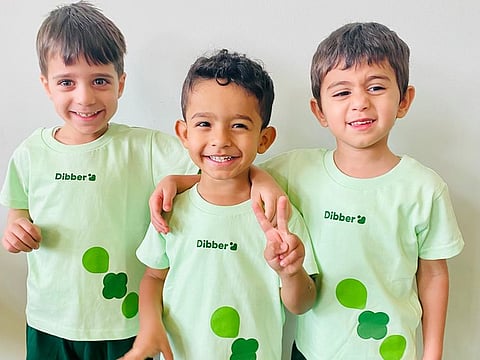Dibber’s purpose: To develop lifelong learners with a heart for the world
Dibber pedagogy is designed to champion children’s well-being, development, and learning

In the nurturing environment of Dibber, young minds not only acquire knowledge but also cultivate a profound sense of mastery and autonomy. They embark on a journey that fosters their innate curiosity, a deep-rooted love for learning, and instils a profound sense of responsibility for all living beings and the health of our precious planet.
The Dibber Childhood©, which represents their pedagogy, is founded on this intrinsic belief. Shauna Ross, the recently appointed Chief Pedagogy Officer, is a key member of the Dibber team and has played a crucial role in developing the Dibber Childhood© framework. “Our pedagogy, deeply rooted in early childhood research, is designed to champion children’s well-being, development, and learning. At the heart of it all lies our Heart Culture, a nurturing force that fortifies and expands a child’s character, connections, and social well-being. It’s a philosophy where intrinsic value and relationships are our top priorities, ensuring every child’s growth and development,’’ says, Shauna.
The Circle Time is planned, structured, and executed every single day by following a recognizable structure and organizing the physical space. It includes elements such as a Learning Friend, a Flying Start, a Theme, and an End Activity:
• Each day, a new Learning Friend welcomes the children and leads circle time. Dibber has 7 Learning Friends which are:
1 Hearty-Howard who is all about kindness and empathy. He helps children talk about the things they are happy about and gives hand hugs.
2 Woody-Woo who is keen to experience the wonders of nature with all his senses. He is wonder struck over everything he sees and experiences. He encourages children to ask questions and helps nurture curiosity.
3 Rhyming-Roger who loves reading, rhymes, and riddles. He encourages children to read – in English and Chinese. Rhyming-Roger cares a lot about how we communicate with one another. He wants us to be positive when we talk. Dibber children do lots of reading!
4 Colour-Paletta who loves colours and encourages children to get creative in different ways. Music, dance, and art are among her favourite things. Colour-Paletta likes to use rhythm and music for acting and storytelling.
5 Counting-Connie who counts everything she sees! She likes arranging and measuring things. She also loves to measure and weigh all sorts of things in the kitchen. Counting-Connie knows that children that love playing with numbers will grow into wonderful mathematicians!
6 Play-Penny who is a lively friend and full of fun and ideas. She wants children to play and explore every day, both indoors and outdoors, to stimulate curiosity and learning.
7 Jumping-Jack who is always moving. He wants children to be active and stay healthy.
• The Flying Start: the first few minutes of circle time are crucial in catching the children’s attention and in creating engagement. “A Flying Start “is a short and engaging activity to set the tone for circle time. This activity can be the same every day or changed according to the Learning Friend of the day.
• The Theme is an activity connected to the theme, topic, and/or project the children are currently engaged in, where all the Learning Friends come together for a holistic and integrated approach.
• The End Activity is a short and recognizable activity to indicate that Circle Time is over.
Dibber's global roots and UAE reach
Established in: 2003 Founded by: Hans Jacob Sundby and Randi Lauvland in Norway Global Centres: 600 nurseries and schools Learners: The group welcomes 50,000 children everyday UAE Centres: 6 nurseries - The Sustainable City, Al Barsha South 2, Damac Hills – Mudon, Jumeirah Golf Estates in Dubai and Khalifa City A in Abu Dhabi
Shauna Ross further emphasizes, ‘‘The duration of Circle Time is adaptable to the age level, maturity, and interests of the children, typically ranging from 5 to 15 minutes. Our Circle Time structure is a guide, not a restriction, enabling our educators to plan and execute sessions that cater to the unique needs of each class. It’s vital that children don’t remain seated throughout the Circle Time. Instead, they should engage their whole bodies, playing, speaking, singing, and actively participating in the learning process.’’
The Circle Time area’s physical environment is also crucial for its success. It’s well-organized with a whiteboard, a calendar, a weather chart, children’s names or photos, and more. There’s a circular green rug that accommodates all children in the class, and items like plants, pillows, and musical instruments.
Dibber’s commitment to creating an engaging learning environment, with the Circle Time at its heart, is a testament to its dedication to nurturing young minds. As Shauna Ross puts it, ‘‘At Dibber, we aim to inspire a lifelong love for learning, and the Circle Time is where this beautiful journey begins.”
With Shauna’s expertise and the Dibber Childhood© framework, children are not only learning but also flourishing in an atmosphere that embraces their curiosity and individuality, setting them on a path towards a bright and promising future.
For details visit dibber.com
Contact number: 800-DIBBER(800-342237)
Sign up for the Daily Briefing
Get the latest news and updates straight to your inbox




